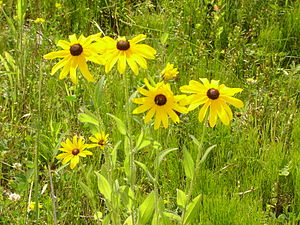Rudbeckia
Rudbeckia is one of at least four genera in the family Asteraceae whose members are commonly known as coneflowers; the others are Echinacea, Dracopis and Ratibida.
A large number of species have been proposed within Rudbeckia, but most are now regarded as synonyms of the limited list given below. Several of these currently accepted species have several accepted varieties. Some of them (for example the Black-eyed Susan, R. hirta), are popular garden flowers, distinguished for their long flowering times. There are many cultivars of these species as well.
Description
editThey are herbaceous, mostly perennial plants (some annual or biennial) growing to 0.5-3 m tall, with simple or branched stems. The leaves are spirally arranged, entire to deeply lobed, 5-25 cm long. The flowers are produced in daisy-like inflorescences, with yellow or orange florets arranged in a prominent, cone-shaped head; "cone-shaped" because the ray florets tend to point out and down (are decumbent) as the flower head opens.
Growing conditions
editSpecies
edit- Rudbeckia alpicola Showy Coneflower
- Rudbeckia auriculata Eared Coneflower
- Rudbeckia bicolor Pinewoods Coneflower
- Rudbeckia californica California Coneflower
- Rudbeckia fulgida Orange Coneflower
- Rudbeckia glaucescens Waxy Coneflower
- Rudbeckia graminifolia Grassleaf Coneflower
- Rudbeckia grandiflora Rough Coneflower
- Rudbeckia heliopsidis Sunfacing Coneflower
- Rudbeckia hirta Black-eyed Susan
- Rudbeckia klamathensis Klamath Coneflower
- Rudbeckia laciniata Cutleaf Coneflower, Green-head Coneflower
- Rudbeckia maxima Great Coneflower
- Rudbeckia missouriensis Missouri Coneflower
- Rudbeckia mohrii Mohr's Coneflower
- Rudbeckia mollis Softhair Coneflower
- Rudbeckia montana Montane Coneflower
- Rudbeckia nitida Shiny Coneflower
- Rudbeckia occidentalis Western Coneflower
- Rudbeckia pinnata Grey-headed Coneflower
- Rudbeckia scabrifolia Roughleaf Coneflower
- Rudbeckia serotina
- Rudbeckia speciosa Showy Coneflower
- Rudbeckia subtomentosa Sweet Coneflower
- Rudbeckia texana Texas Coneflower
- Rudbeckia triloba Brown-eyed Susan
Uses
editMany species are used in prairie restorations and for ornamental use. Used by domestic stock for forage. An abundance of these plants on a rangeland indicates good health.
Maintenance
editPropagation
editDivision or seed.
Harvesting
editPests and diseases
editRudbeckia species are used as food plants by the larvae of some Lepidoptera species including w:Cabbage Moth and w:Dot Moth.
